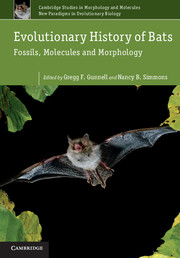Book contents
- Frontmatter
- Contents
- Contributors
- Preface
- 1 Phylogenies, fossils and functional genes: the evolution of echolocation in bats
- 2 Systematics and paleobiogeography of early bats
- 3 Shoulder joint and inner ear of Tachypteron franzeni, an emballonurid bat from the Middle Eocene of Messel
- 4 Evolutionary history of the Neotropical Chiroptera: the fossil record
- 5 New basal noctilionoid bats (Mammalia: Chiroptera) from the Oligocene of subtropical North America
- 6 Necromantis Weithofer, 1887, large carnivorous Middle and Late Eocene bats from the French Quercy Phosphorites: new data and unresolved relationships
- 7 African Vespertilionoidea (Chiroptera) and the antiquity of Myotinae
- 8 Evolutionary and ecological correlates of population genetic structure in bats
- 9 A bird? A plane? No, it's a bat: an introduction to the biomechanics of bat flight
- 10 Toward an integrative theory on the origin of bat flight
- 11 Molecular time scale of diversification of feeding strategy and morphology in New World Leaf-Nosed Bats (Phyllostomidae): a phylogenetic perspective
- 12 Why tribosphenic? On variation and constraint in developmental dynamics of chiropteran molars*
- 13 Necromantodonty, the primitive condition of lower molars among bats
- 14 Echolocation, evo-devo and the evolution of bat crania
- 15 Vertebral fusion in bats: phylogenetic patterns and functional relationships
- 16 Early evolution of body size in bats
- Index
- Plate section
- References
2 - Systematics and paleobiogeography of early bats
Published online by Cambridge University Press: 05 June 2012
- Frontmatter
- Contents
- Contributors
- Preface
- 1 Phylogenies, fossils and functional genes: the evolution of echolocation in bats
- 2 Systematics and paleobiogeography of early bats
- 3 Shoulder joint and inner ear of Tachypteron franzeni, an emballonurid bat from the Middle Eocene of Messel
- 4 Evolutionary history of the Neotropical Chiroptera: the fossil record
- 5 New basal noctilionoid bats (Mammalia: Chiroptera) from the Oligocene of subtropical North America
- 6 Necromantis Weithofer, 1887, large carnivorous Middle and Late Eocene bats from the French Quercy Phosphorites: new data and unresolved relationships
- 7 African Vespertilionoidea (Chiroptera) and the antiquity of Myotinae
- 8 Evolutionary and ecological correlates of population genetic structure in bats
- 9 A bird? A plane? No, it's a bat: an introduction to the biomechanics of bat flight
- 10 Toward an integrative theory on the origin of bat flight
- 11 Molecular time scale of diversification of feeding strategy and morphology in New World Leaf-Nosed Bats (Phyllostomidae): a phylogenetic perspective
- 12 Why tribosphenic? On variation and constraint in developmental dynamics of chiropteran molars*
- 13 Necromantodonty, the primitive condition of lower molars among bats
- 14 Echolocation, evo-devo and the evolution of bat crania
- 15 Vertebral fusion in bats: phylogenetic patterns and functional relationships
- 16 Early evolution of body size in bats
- Index
- Plate section
- References
Summary
Introduction
The phylogenetic and geographic origins of most extant mammalian orders are still poorly documented. Many first appear in the fossil record during the Paleocene-Eocene Thermal Maximum (PETM) at the beginning of the Eocene epoch about 55.5 million years ago (Smith et al., 2006). However, three prominent orders are exceptions to this pattern. Rodents first appeared in North America about 0.5–1.0 million years before the PETM, but probably had an Asian origin like other Glires (Meng et al., 2003). Bats and whales are not known with any certainty before Middle Ypresian, about 54 mya.
The earliest known bats are small, insectivorous forms that are preserved in both terrestrial and lacustrine fossil faunas. Their phylogenetic and geographic origins are still unknown, although the absence of clear transitional forms in the fossil record suggests that bat origins are potentially either quite ancient or their evolution from non-volant mammals was quite rapid. Although morphological evidence has generally supported an origin from within Euarchontoglires, sequence data from multiple genes strongly supports an origin of bats from within Laurasiatheria (Springer et al., 2003; Gunnell and Simmons, 2005).
The oldest known fossil bats are early-middle Early Eocene taxa, and the first members of modern bat families and superfamilies seem to appear in the fossil record in the Middle Eocene (Gunnell and Simmons, 2005). We thus here restrict the term “early bats” to the species known from the Early and early-middle Middle Eocene (Ypresian and Lutetian, and global equivalents, encompassing European mammalian reference levels MP7 through MP13). These early bats mainly include “eochiropterans” (Eochiroptera Van Valen 1979 is a controversial paraphyletic group composed of primitive taxa; see Simmons and Geisler, 1998 for an overview) and a few taxa belonging to the first members of modern families.
- Type
- Chapter
- Information
- Evolutionary History of BatsFossils, Molecules and Morphology, pp. 23 - 66Publisher: Cambridge University PressPrint publication year: 2012
References
- 26
- Cited by

